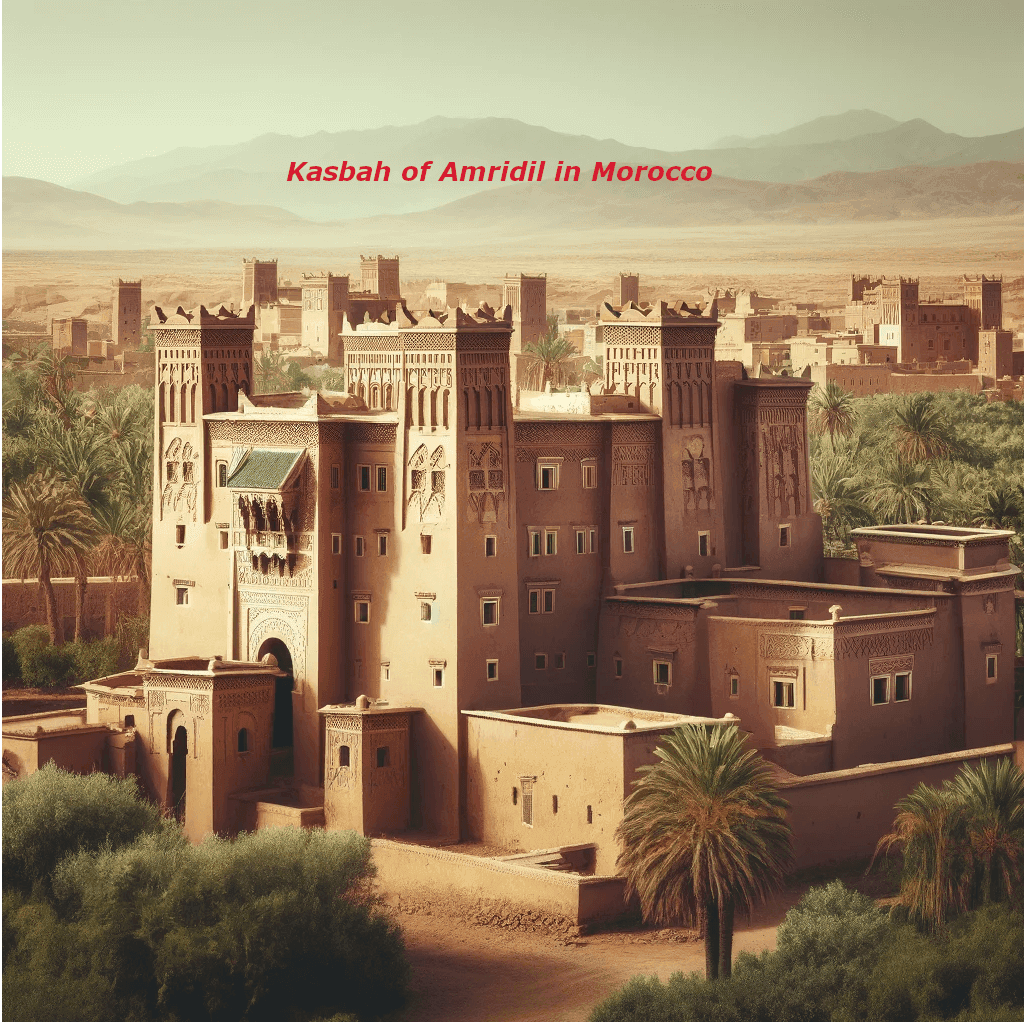The Iconic Kasbah of Amridil
The Kasbah of Amridil is one of Morocco’s most treasured historical sites, nestled in the lush Skoura Oasis along the Route of a Thousand Kasbahs. This majestic structure, built in the 17th century, is a prime example of traditional Moroccan architecture and holds a special place in the country’s cultural and historical landscape. With its prominent walls, this architectural masterpiece presents detailed designs at a valuable position. It provides sightseers with a learning experience about Morocco’s marvelous cultural background. The ancient space needs to be seen by everybody because it embodies Moroccan architecture alongside typical daily customs for travelers, cultural lovers, and picture enthusiasts.
History of the Kasbah of Amridil
The Kasbah’sKasbah’s Origins and Cultural Importance
During the 1600s, the Nassiri family created the Kasbah of Amridil to safeguard the Skoura Oasis against attacks while securing its populations. Since its construction in the 1600s, it has transformed into a lively center for local commerce and cultural activities, showcasing prosperity throughout the area. It remains a historical emblem of Moroccan heritage, standing as a testament to the lives and traditions of the people who called it home.
Preservation Efforts and UNESCO Recognition
While the Kasbah itself is not officially listed as a UNESCO World Heritage Site, cultural organizations, and Moroccan authorities have supported efforts to preserve similar kasbahs along the Route of a Thousand Kasbahs. Tourists can visit Amridil as descendants of the family preserve the house while maintaining its original state to showcase both items and the restored architecture within its historic rooms.
Architectural Significance of the Kasbah
People recognize the Kasbah of Amridil as showcasing genuine traditional Moroccan architectural design authenticity. It is built primarily with clay, straw, and wood and is well-suited to the desert environment.
Traditional Moroccan Architecture
The Kasbah’sKasbah’s design features tall towers, crenelated walls, and ornate carvings. Islamic architectural influences are visible in its geometric patterns and arches. Intricate stucco wall designs at Kasbah blend the signification of Moroccan artistic symbolism with protection and religious meanings.
Construction Materials and Design Elements
At the Kasbah, builders used natural resources, including clay and straw, to create walls that appear to be a rich earthen mixture harmonizing with the desert environment. This method of building, known as rammed earth construction, has been used for centuries across Morocco due to its durability and insulation properties, keeping the Kasbah cool during the day and warm at night. Notable features include the staircases and wooden beams of palm and olive wood, adding texture and warmth to the fortress-like design.
Why Visit the Kasbah of Amridil?
Experiencing Traditional Moroccan Life
Tourists accessing the Kasbah of Amridil receive genuine exposure to Moroccan traditional customs. Restored rooms offer visitors access to see traditional household artifacts including common tools and cooking instruments which maintain their original placement. Display cases present genuine cultural practices belonging to early inhabitants of the area who shaped its historical traditions.
Scenic Surroundings of the Skoura Oasis
The Kasbah occupies a beautiful setting in the Skoura Oasis, which captures tourists with its expansive palm groves and lovely gardens that frame a sight line toward the snowy peaks of the Atlas Mountains. The lush palm trees and gardens allow visitors to wander around a serene, picturesque setting that suits relaxation and photography well.
Visitor Information and Statistics
Annual Visitor Statistics and Economic Impact
Tourists flock every year to visit the Kasbah of Amridil, thus benefiting the local economic growth while assisting in the preservation project for nearby Kasbahs. The Moroccan Ministry of Tourism statistics show that the Skoura Oasis receives more than 50,000 visiting tourists yearly, and the Kasbah of Amridil is one of their main draws. Sightseers who explore these areas make spending possible for local business operators, including tour agencies, art, scans, and hospitality providers, leading to durable regional tourism.
Entry Fees, Hours, and Accessibility
- Entry Fee: Approximately 20-30 Moroccan Dirhams (MAD), with additional fees for guided tours.
- Hours of Operation: It is typically open from 9 AM to 5 PM daily, but checking in advance is advisable, especially during national holidays.
- Accessibility: Kasbah’s narrow staircases and uneven pathways may present challenges for visitors with limited mobility, but assistance is available upon request.
How to Reach the Kasbah of Amridil
Directions from Popular Moroccan Destinations
The Kasbah of Amridil is conveniently located near Ouarzazate, the gateway to the Sahara Desert. A five-hour journey leads through the twisting paths of the High Atlas Mountains between Marrakech, delivering remarkable scenery to showcase Morocco’s multiple terrain types. Most people decide to use guided tours, which combine transportation with an expert guide to provide a richer experience.
Transportation Options
Traveling independently means renting a car, which provides the best flexibility. This allows you to explore the Kasbah and nearby attractions at your own pace. Alternatively, public buses and shared taxis are available from Ouarzazate to Skoura, and local guides can assist with further directions.
Other Attractions Near the Kasbah of Amridil
Natural landscapes and historical attractions surrounding Amridil’s Kasbah area allow visitors to extend their travel time.
- Valley of Roses: Every spring, the outdoor event transforms the Valley of Roses outside Skoura into a gathering space for cultural festivals based on farming practices throughout the year.
- Ait Ben Haddou: Ait Ben Haddou stands as a UNESCO World Heritage Site and movie set for Gladiator and Game of Thrones, while functioning as a historic ksar (fortified village).
- Dades Valley: Dades Valley delivers dramatic gorges, scenic views, hiking paths, and rock formations that provide openness to mountain ranges.
Conclusion
The historical structure of the Kasbah of Amridil represents Moroccan history through its roles as both a monument of past resilience and artistic achievements and traditional preservation. Centuries of historical development find their place inside the Kasbah’s clay structures through its breathtaking architecture along with cultural artifacts. All people fascinated by Morocco’s cultural legacy or lovers of history and photography will find the Amridil Kasbah leads them to its authentic heart.
External References and Sources
- UNESCO World Heritage List (for nearby sites like Ait Ben Haddou): UNESCO Site

